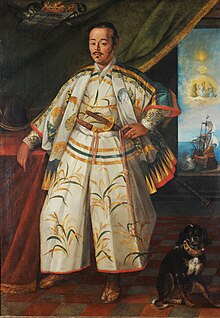Hasekura Tsunenaga
| Hasekura Tsunenaga 支倉常長 |
|
|---|---|

Hasekura's portrait during his mission in Rome in 1615 by Claude Deruet
|
|
| Born |
Hasekura Rokuemon Tsunenaga c. 1571 Sendai Domain, Northeastern Japan |
| Died | 7 August 1622 (aged 50–51) Ōsato, Miyagi, Japan |
| Other names | Don Felipe Francisco Hasekura (Christianized name) |
| Occupation | Diplomat |
| Children | Hasekura Yoritomo (d. 1640), Hasekura Yorimichi (?-?) |
Hasekura Rokuemon Tsunenaga (or "Philip Francis Faxicura", baptized as "Francisco Felipe Faxicura", in Spain) (1571–1622) (Japanese: 支倉六右衛門常長, also spelled Faxecura Rocuyemon in period European sources, reflecting the contemporary pronunciation of Japanese) was a Roman noble of Japanese imperial descent with ancestral ties to Emperor Kanmu and a Japanese samurai and retainer of Date Masamune, the daimyō of Sendai.
In the years 1613 through 1620, Hasekura headed a diplomatic mission to the Vatican in Rome, traveling through New Spain (arriving in Acapulco and departing from Veracruz) and visiting various ports-of-call in Europe. This historic mission is called the Keichō Embassy (慶長使節), and follows the Tenshō embassy (天正使節) of 1582. On the return trip, Hasekura and his companions re-traced their route across Mexico in 1619, sailing from Acapulco for Manila, and then sailing north to Japan in 1620. He is conventionally considered the first Japanese ambassador in the Americas and in Europe.
Although Hasekura's embassy was cordially received in Europe, it happened at a time when Japan was moving toward the suppression of Christianity. European monarchs such as the King of Spain thus refused the trade agreements Hasekura had been seeking. Hasekura returned to Japan in 1620 and died of illness a year later, his embassy seemingly ending with few results in an increasingly isolationist Japan.
Japan's next embassy to Europe would only occur more than 200 years later, following two centuries of isolation, with the "First Japanese Embassy to Europe" in 1862.
...
Wikipedia
